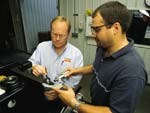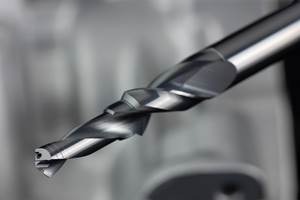Retooling Saves Time And Space
Fermer Precision machines a variety of precision parts from aluminum, cast iron, powdered metal, carbon steel and low-carbon steel for automobiles, firearms, medical products and train brake systems. The company relies on a Mori Seiki SV-500 and two OKK KVC 600 vertical machining centers for drilling, reaming and chamfering operations.
Fermer Precision (Ilion, New York) machines a variety of precision parts from aluminum, cast iron, powdered metal, carbon steel and low-carbon steel for automobiles, firearms, medical products and train brake systems. The company relies on a Mori Seiki SV-500 and two OKK KVC 600 vertical machining centers for drilling, reaming and chamfering operations. Typical drilling requirements for the machines are to drill nine holes in six workpieces mounted in a single fixture.
A retooling process started when Rick Bunce, engineering manager, decided that tool life on the drilling operation was unacceptable. The powdered-metal core drills were supposed to last 200 parts per drill, but they were only averaging 120. Mr. Bunce was also concerned about operator safety when it came time to replace dulled drills. Operators were at risk of burning their hands when removing the tooling from the shrink-fit toolholders.
"The shrink-fit toolholders are very difficult to use at times," explains Mr. Bunce. "Any time you use tools with steel shanks as opposed to solid carbide, the coefficient of expansion of the toolholder and the tool's steel shank are too close to the same. Because of this, as the toolholder is heated, to release the tool, the shank grows at almost the same rate. In most cases, you need to use a mallet and a drive punch to remove the tool.
"After replacement of the drill, the toolholder still could not be used for another 1.5 hours. It took that long to cool down enough for handling and then retooling," explains Mr. Bunce. "It was during the reheating and cooling of the shrink-fit toolholder that the operators ran the risk of injury."
The long retooling times required Fermer to keep on hand three times the number of toolholders actually needed for drilling. "We had to stock more tooling to keep the vertical milling machine running. While some of the toolholders were being used in the machine, others were cooling following a tool change. Still others were idle near the machining centers waiting to be reinstalled," continues Mr. Bunce.
Mr. Bunce contacted his DoAll representative to discuss alternative tools. DoAll and Sandvik Coromant (Fair Lawn, New Jersey) teamed up to come up with a solution for longer tool life. Fermer's solution proved to be a high precision, hydromechanical clamping toolholder and a dual-grade drill with high toughness and good wear resistance—Sandvik's Delta C GC1020 drill and the Sandvik CoroGrip toolholder.
Although Fermer Precision initially set out to improve throughput on its precision vertical and horizontal machining centers, the company got a whole lot more. It reduced tooling inventory and setup time from hours to seconds and eliminated its existing drills and shrink-fit toolholders. The key to the new drill's performance is the sintering of two substrate materials together at the drill tip. The grade at the tool center provides toughness and withstands tension and pressure on the drill point. The grade at the tool periphery provides wear resistance at high surface speed. This combination results in high speeds and feeds without sacrificing edge security.
While the drill was being tested, the Sandvik sales representative, Paul Ashmore, and the DoAll sales representative, Bill Golder, also suggested that Mr. Bunce try out the CoroGrip high precision chuck for high speed machining. Its design offers twice the clamping force of shrink-fit chucks and three times that of ordinary hydraulic chucks.
After two weeks of use on actual production parts, Mr. Bunce quickly wrote out a purchase order for the composite drill and the high precision chuck.
Right away, the tooling combination demonstrated dramatically longer tool life. The average number of parts each drill handled increased from 120 to 300. Depending on the application, Fermer gained an increase from 50 to 200 percent on tool life. "Sandvik's combination of the TwinGrade drill and the hydromechanical chuck is the greatest," says Mr. Bunce. "If I had to give up this tooling now, I would rather go back to using set holes than the shrink-fit toolholders we were using for drilling and reaming."
The low-runout design of the CoroGrip was another big-ticket feature for Mr. Bunce. "The nearly non-existent runout we have with this toolholder is just great. The drills and reamers for our applications have to be right on the money, and the CoroGrip is incredibly close," he adds. Runout on the CoroGrip is 0.002 mm.
Feeds and speeds on the machines remain unchanged with the new drill and toolholder. A typical operation is drilling several 0.4313-inch diameter holes, 1 ¾ inch deep at 250 sfm in low-carbon steel workpieces. Programming on the machining center indexes the Delta C drill into place to perform all hole drilling, then indexes a reamer to ream out the holes.
A pleasant improvement for Fermer technicians was the safe, easy and quick tooling setup with the CoroGrip chucks. The toolholders are fitted with a tool and ready for insertion into the machines in just 15 seconds," says Mr. Bunce. "That is 360 times faster than the setup time required for the shrink-fit toolholders."
As a result of faster setup, Fermer no longer needs to inventory more toolholders than necessary to support its drilling operations. "We still have multiple toolholders. This is so we can simply pop in a toolholder when a tool becomes dull and keep the machine up and running. This strategy has added hundreds of hours a year to our useable machine time," says Mr. Bunce.
Gone are the gloves and mallet necessary to change drills. Also, a simple tool pot (in Fermer's presetter) is all that is needed to hold the toolholder during tool insertion. During tool setup there are no forces exerted on the clamp or the tool pot, since only shop air is applied to move internal toolholder components.
The design of the CoroGrip toolholder optimizes balance and torque transmission. The absence of a set screw means the tool has good balance for minimal, if any, vibration during operation. "This toolholding system allows us to get the best performance from Sandvik's solid carbide drilling tools. The combination has increased overall productivity and the quality of our products," concludes Mr. Bunce.
Related Content
Tungaloy Drills, Milling Inserts Provide Enhanced Stability
Tungaloy has expanded its DrillForceMeister and TecMill lines with new drill bodies and milling inserts.
Read MoreEmuge-Franken's New Drill Geometry Optimizes Chipbreaking
PunchDrill features patent-pending geometry with a chipbreaker that produces short chips to control machining forces.
Read MoreForm Tapping Improves Tool Life, Costs
Moving from cut tapping to form tapping for a notable application cut tooling costs at Siemens Energy and increased tool life a hundredfold.
Read MoreKennametal Expands Modular Drilling Platform
The KenTip FS GTP insert allows for multiple machining applications across materials including steel, stainless steel and cast iron.
Read MoreRead Next
The Future of High Feed Milling in Modern Manufacturing
Achieve higher metal removal rates and enhanced predictability with ISCAR’s advanced high-feed milling tools — optimized for today’s competitive global market.
Read MoreRego-Fix’s Center for Machining Excellence Promotes Collaboration
The new space includes a showroom, office spaces and an auditorium that will enhance its work with its technical partners.
Read MoreRegistration Now Open for the Precision Machining Technology Show (PMTS) 2025
The precision machining industry’s premier event returns to Cleveland, OH, April 1-3.
Read More



















.jpg;maxWidth=300;quality=90)



.jpg;maxWidth=300;quality=90)







